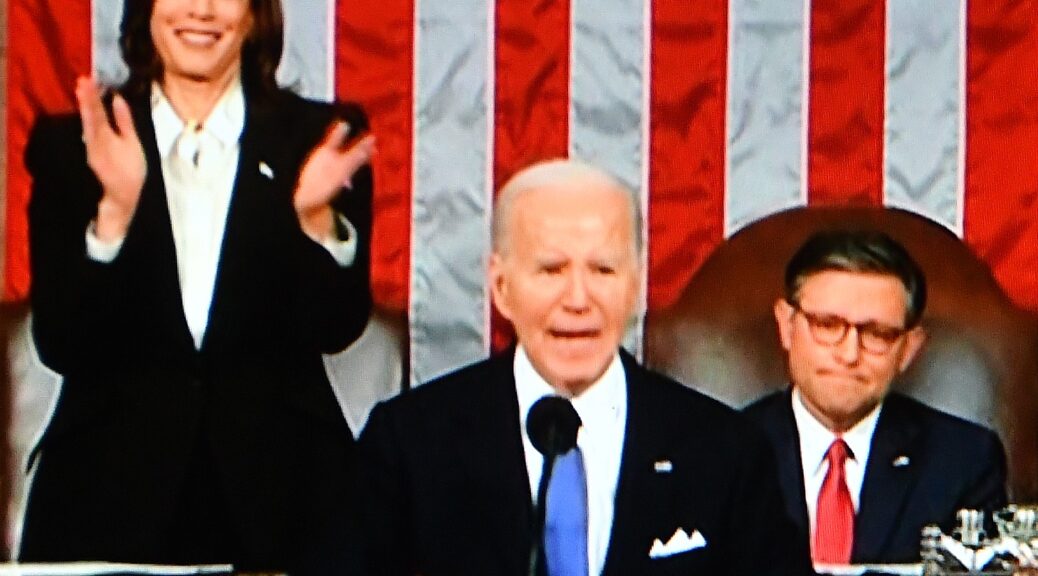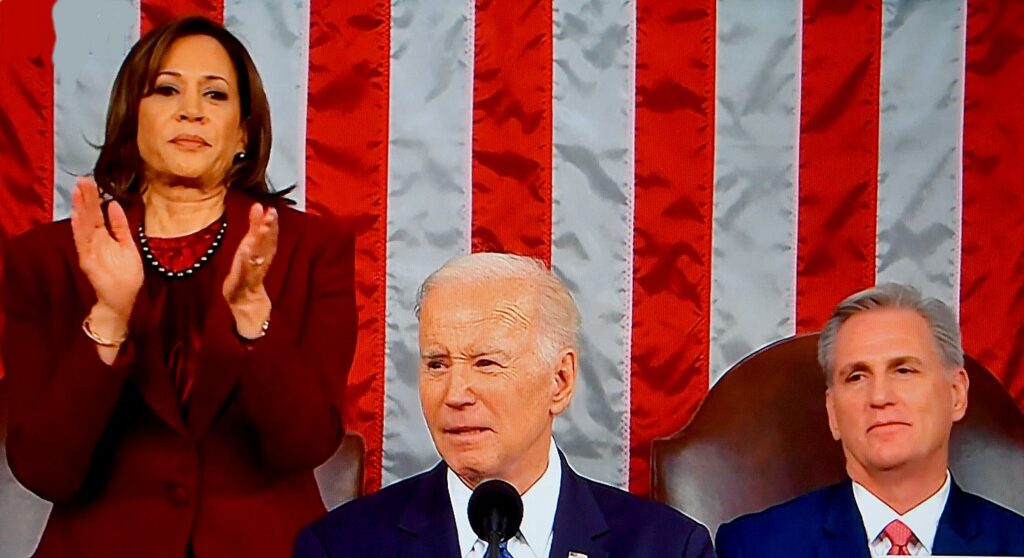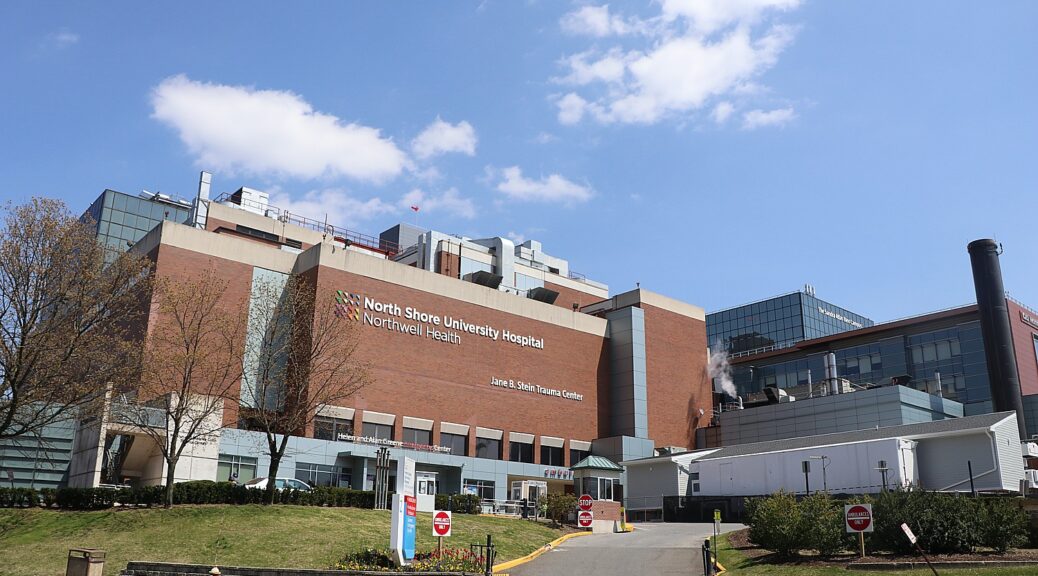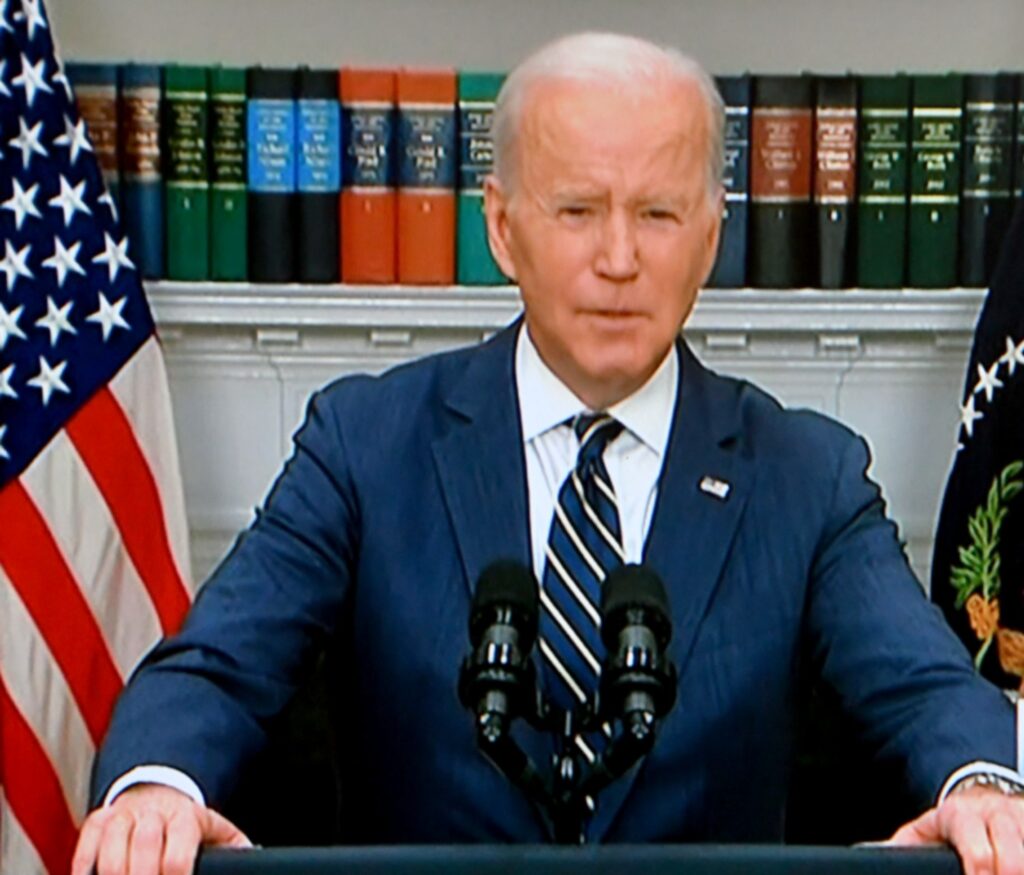Budget Details Vision to Protect Progress, Lower Costs, Protect and Strengthen Social Security and Medicare, Invest in America and the American People, and Reduce the Deficit
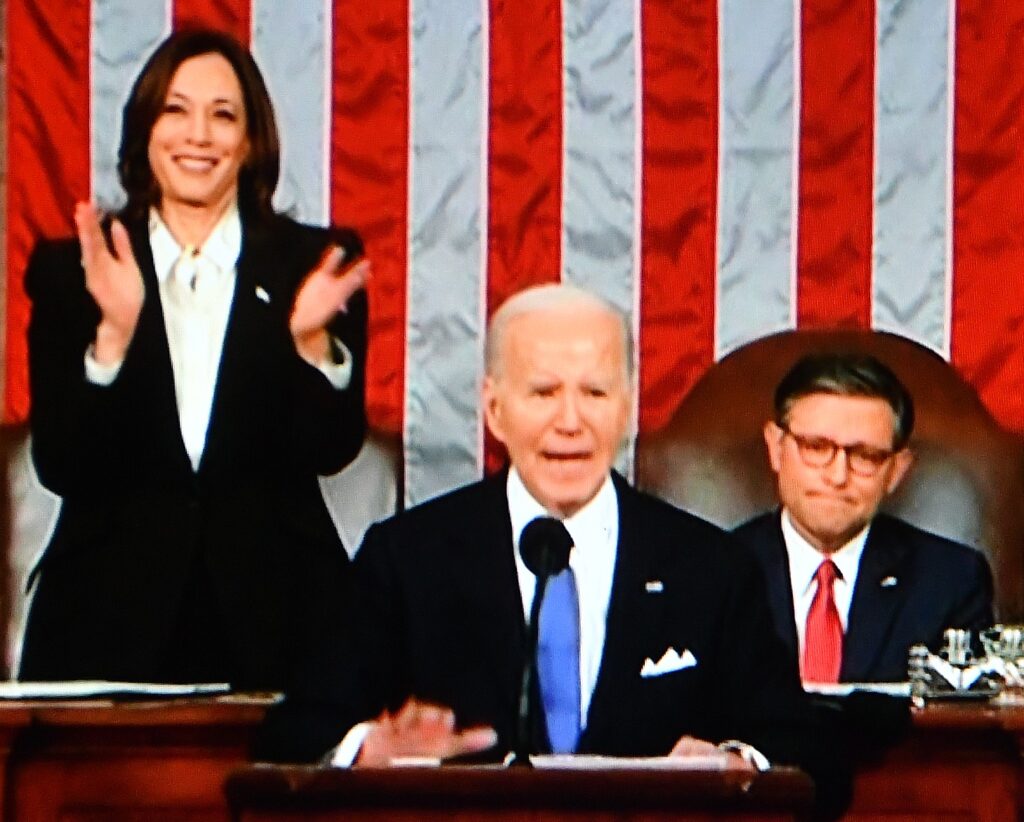
From Day One of this Administration, President Biden has tackled challenges head-on while delivering long-lasting results. Over the past three years, he has overseen a strong economic recovery, amassed one of the most successful legislative records in generations, grown the economy from the middle out and bottom up, and delivered important progress for the American people.
Since the President and Vice President took office, the economy has added about 15 million jobs, the unemployment rate has remained below 4 percent for two years in a row—a more than 50-year record—while inflation has fallen by two-thirds. Our strong labor market has meant higher paychecks for working Americans, with inflation-adjusted wages and wealth higher now than before the pandemic. The President’s top economic priority remains lowering costs for hardworking Americans. Under his leadership, the Administration is working to bring down prescription drug costs, health insurance premiums, utility bills, and costs for everyday goods and services—all while taking on junk fees that some banks, airlines, and other big corporations use to rip off Americans. At the same time, he has also restored U.S. leadership on the world stage while keeping Americans safe and promoting democracy at home and abroad.
The President has delivered this progress while fulfilling his commitment to fiscal responsibility. The deficit is over $1 trillion lower than when President Biden took office, thanks in large part to the strength of our economic recovery. In addition, the President has also enacted another roughly $1 trillion in savings over the next decade through the Fiscal Responsibility Act, and through Inflation Reduction Act provisions that empower Medicare to negotiate lower prescription drug prices, cap insulin at $35 per month for seniors, and make our tax system fairer by making billion-dollar corporations pay a minimum tax and enabling the IRS to crack down on wealthy and corporate tax cheats.
The Budget details the President’s vision to protect and build on his Administration’s progress by continuing to lower costs for working families, protect and strengthen Social Security and Medicare, invest in America and the American people to make sure the middle class has a fair shot and we leave no one behind, and reduce the deficit by cracking down on fraud, cutting wasteful spending, and making the wealthy and corporations pay their fair share. Building on the President’s record of fiscal responsibility, his Budget reduces the deficit by $3 trillion over the next 10 years—on top of paying for new investments.
The President’s vision of progress, possibilities, and resilience is in stark contrast to Congressional Republicans, who have repeatedly fought to slash critical programs the American people count on and increase the deficit by hundreds of billions of dollars, including by attempting to repeal the parts of the Inflation Reduction Act that take on special interests like Big Pharma, big corporations, and wealthy tax cheats. The President’s Budget:
Lowers Costs for the American People
The President has made lowering costs for hardworking families his top domestic priority. Under his leadership we have seen significant progress bringing down inflation. Inflation is down by more than two-thirds, and costs have fallen for key household purchases from a gallon of gas to a gallon of milk. While Congressional Republicans have consistently taken actions that would raise costs for working families, the President’s Budget would continue lowering costs for families.
Lowers Drug Prices and Expands Access to Prescription Drugs. Thanks to action taken by the Administration, millions of seniors and people with disabilities are saving money on their drug costs, and the Administration announced the first ten drugs for which prices will be negotiated as it continues implementation of the Inflation Reduction Act. The Budget builds on this success by significantly increasing the pace of negotiation, bringing more drugs into negotiation sooner after they launch, expanding the Inflation Reduction Act’s inflation rebates and $2,000 out-of-pocket prescription drug cost cap beyond Medicare and into the commercial market, and other steps to build on the Inflation Reduction Act drug provisions. In addition, the Budget extends the $35 cost-sharing cap for a month’s supply of insulin to the commercial market. The Budget also includes proposals to ensure Medicaid and the Children’s Health Insurance Program (CHIP) are prudent purchasers of prescription drugs and limits Medicare Part D cost-sharing for high-value generic drugs, such as those used to treat hypertension and hyperlipidemia, to no more than $2 per month for Medicare beneficiaries. These reforms will not only cut costs for the Federal government by $200 billion; they will also save billions of dollars for seniors.
Cuts Taxes for Families with Children and American Workers. President Biden’s tax cuts cut child poverty in half in 2021 and are saving millions of people an average of about $800 per year in health insurance premiums today. Going forward, in addition to honoring his pledge not to raise taxes on anyone earning less than $400,000 annually, President Biden’s tax plan would cut taxes for middle- and low-income Americans by $765 billion over 10 years. The Budget restores the full Child Tax Credit enacted in the American Rescue Plan, which helped cut child poverty nearly in half in 2021 to its lowest level in history and narrowed racial disparities in access to the credit. The President’s Budget would restore the expanded Child Tax Credit, lifting 3 million children out of poverty and cutting taxes by an average of $2,600 for 39 million low- and middle-income families that include 66 million children. This includes 18 million children in low-income families who would be newly eligible for the full credit, and 2 million children living with a caregiver who is at least 60 years old. It would also provide breathing room for day-to-day expenses by allowing families to receive their tax credit through monthly payments. And by strengthening the Earned Income Tax Credit for low-paid workers who aren’t raising a child in their home, the President’s Budget would cut taxes by an average of $800 for 19 million working individuals or couples. That includes 2 million older workers age 65 and older and 5 million young adults age 18 to 24 who would be newly eligible for the credit.
Lowers Child Care Costs for Hard-Working Families. The President is committed to providing relief to hard-working families. His Budget creates a historic new program under which working families with incomes up to $200,000 per year would be guaranteed affordable, high-quality child care from birth until kindergarten, with most families paying no more than $10 a day, and the lowest income families paying nothing—providing a lifeline to the parents of more than 16 million children. The Budget also includes $8.5 billion for the Child Care and Development Block Grant (CCDBG) which will help states expand child care assistance to serve over 2 million low-income children.
Increases Affordable Housing Supply to Reduce Housing Costs. The President believes that all Americans should be able to afford a quality home, which is why the Budget includes a historic investment of more than $258 billion that would build or preserve over 2 million units. The Budget builds on previous investments and actions by this Administration to boost housing supply and lower housing costs, particularly for lower- and middle-income households. The Budget expands the existing Low-Income Housing Tax Credit and proposes a new Neighborhood Homes Tax Credit. To further address the critical shortage of affordable housing in communities throughout the Nation, the Budget provides $20 billion in mandatory funding for a new Innovation Fund for Housing Expansion. The Budget invests $1.3 billion in the HOME Investment Partnerships Program (HOME) to construct and rehabilitate affordable rental housing and provide homeownership opportunities. The Budget also provides $7.5 billion in mandatory funding for new Project-Based Rental Assistance contracts to incentivize the development of new climate-resilient affordable housing. Together these proposals would expand the supply of safe and affordable housing, bring new units to market, and ultimately help curb cost growth across the broader rental market.
Expands Access to Homeownership and Affordable Rent and Reduces Down Payments for First-Time and First-Generation Homebuyers. The Budget proposes a new Mortgage Relief Credit to help increase access to affordable housing. The proposal includes a new tax credit for middle-class first-time homebuyers of up to $10,000 over two years to ease affordability challenges. In addition, to unlock starter home inventory and allow middle-class families to move up the housing ladder and empty nesters to right size, the President is calling on Congress to provide a one-year tax credit of up to $10,000 to middle-class families who sell their starter home. The Budget also provides $10 billion in mandatory funding for a new First-Generation Down Payment Assistance program to address homeownership and wealth gaps. For renters, the Budget proposes $32.8 billion in discretionary funding for the Housing Choice Voucher Program to maintain and protect critical services for all currently assisted families and support an additional 20,000 households. The Budget also provides $9 billion to establish a housing voucher program for all 20,000 youth aging out of foster care annually, and provides $13 billion to incrementally expand rental assistance for 400,000 extremely low-income veteran families, paving a path to guaranteed assistance for all who have served the Nation and are in need.
Reduces the Cost of College and Lifts the Burden of Student Debt. From Day One of his Administration, President Biden vowed to fix the student loan system and make sure higher education is a pathway to the middle class—not a barrier to opportunity. Already, the President has cancelled more student debt than any President in history, approving debt cancellation for nearly 4 million borrowers through more than two dozen executive actions. The Budget includes a $12 billion mandatory Reducing the Costs of College Fund that will fund strategies to lower college costs for students, including a new Classroom to Career Fund that will enable students to more affordably obtain postsecondary degrees by increasing access to career-connected dual enrollment opportunities. The Budget also builds on the President’s historic actions to reduce student debt and the cost of college by eliminating the origination fees charged to borrowers on every new federal student loan, which costs families billions. In addition, to help low- and middle-income students overcome financial barriers to postsecondary education, the Budget proposes to increase the discretionary maximum Pell Grant by $100 and thereby expand the reach of the program to help over 7.2 million students attend a public or non-profit college. The Budget builds on successful bipartisan efforts to increase the maximum Pell Grant award by $900 over the past two years—the largest increase in more than 10 years. The Budget also expands free community college through a Federal-State partnership and provides two years of subsidized tuition for students from families earning less than $125,000 enrolled in a four-year Historically Black College and University (HBCU), Tribally Controlled College and University (TCCU), or Minority-Serving Institution (MSI).
Lowers Health Care Costs. The President believes that healthcare is a right, not a privilege. With enrollment in Marketplace coverage at an all-time high, the Budget builds on the incredible success of the Affordable Care Act by making permanent the expanded premium tax credits that the Inflation Reduction Act extended, and providing Medicaid-like coverage to individuals in States that have not adopted Medicaid expansion, paired with financial incentives to ensure States maintain their existing expansions. For Medicaid and CHIP, the Budget allows States to extend the existing 12-month continuous eligibility for all children to 36 months, and allows States to provide continuous eligibility for children from birth until they turn age 6. Further, the Budget prohibits enrollment fees and premiums in CHIP.
Reduces Home Energy and Water Costs. The Budget provides $4.1 billion for the Low Income Home Energy Assistance Program (LIHEAP), helping families access home energy and weatherization assistance—vital tools for protecting families from extreme weather and climate change. In addition, the Budget proposes to allow States the option to use a portion of their LIHEAP funds to provide water bill assistance to low-income households.
Protects and Strengthens Social Security and Medicare
Social Security and Medicare are more than government programs, they’re a promise—a rock-solid guarantee that generations of Americans have counted on—that after a life of hard work, you will be able to retire with dignity and security. As the President has made clear, he will reject any efforts to cut or undermine the Medicare or Social Security benefits that seniors and people with disabilities have earned and paid into their entire working lives. The Budget honors that ironclad commitment by firmly opposing benefit cuts to either program and by embracing reforms that would protect and strengthen these programs. The President remains committed to working with the Congress to protect and strengthen Medicare and Social Security for this and future generations and strongly rejects Congressional Republicans’ attempts to cut benefits for hardworking Americans.
Protects and Strengthens Medicare. The Budget strengthens Medicare by extending the solvency of the Medicare Hospital Insurance (HI) trust fund indefinitely by modestly increasing the Medicare tax rate on incomes above $400,000, closing loopholes in existing Medicare taxes, and directing revenue from the Net Investment Income Tax into the HI trust fund as was originally intended. The Budget closes the loophole that allows certain business owners to avoid paying Medicare taxes on these profits and raises Medicare tax rates on earned and unearned income from 3.8 percent to 5 percent for those with incomes over $400,000. In addition, the Budget directs an amount equivalent to the savings from the proposed Medicare drug reforms into the HI trust fund.
Protects the Social Security Benefits that Americans Have Earned. The Administration is committed to protecting and strengthening Social Security. In particular, the Administration looks forward to working with Congress to responsibly strengthen Social Security in a way that ensures no benefit cuts; extends solvency by asking the highest-income Americans to pay their fair share; and improves financial security for seniors and people with disabilities, especially those who face the greatest challenges making ends meet.
Ensures That Americans Can Access the Benefits They’ve Earned. The Budget also invests in staff, information technology, and other improvements at the Social Security Administration (SSA), which will improve customer service at SSA’s field offices, State disability determination services, and teleservice centers for retirees, individuals with disabilities, and their families.
Cuts the Deficit by Promoting Tax Fairness
The President has demonstrated that we can invest in America while achieving meaningful deficit reduction. The deficit is over $1 trillion lower than when President Biden took office, and the President has enacted roughly $1 trillion in additional deficit reduction, including through provisions that empower Medicare to negotiate lower prescription drug prices, cap insulin at $35 per month for seniors and people with disabilities, and establish a minimum tax for large corporations. The Administration looks forward to building on this progress with responsible investments that continue to grow America’s economy from the middle out and bottom up while improving the long-term budget outlook. The Budget proposes another roughly $3 trillion in savings over the next 10 years by making the wealthy and large corporations pay their fair share and closing tax loopholes and cutting wasteful spending on Big Pharma, Big Oil, corporate jets and other special interests, and cracking down on wealthy tax cheats. The President’s proposals to reduce the deficit are in sharp contrast to Congressional Republicans plans for tax giveaways skewed to wealthy and big corporations.
Requires Billionaires to Pay at Least 25 Percent of Income in Taxes. Billionaires make their money in ways that are often taxed at lower rates than ordinary wage income, or sometimes not taxed at all, thanks to giant loopholes and tax preferences that disproportionately benefit the wealthiest taxpayers. As a result, many of these wealthy Americans are able to pay an average income tax rate of just 8 percent on their full incomes—a lower rate than many firefighters or teachers. To finally address this glaring inequity, the President’s Budget includes a 25 percent minimum tax on the wealthiest 0.01 percent, those with wealth of more than $100 million.
Raises Tax Rates for Large Corporations. Corporations received an enormous tax break in 2017. While their profits soared, their investment in their workers and the economy did not. Their shareholders and top executives reaped the benefits, without the promised trickle down to workers, consumers, or communities. The President’s Budget would set the corporate tax rate at 28 percent, still well below the 35 percent rate that prevailed prior to the 2017 tax law. In addition, the Budget would raise the Inflation Reduction Act’s corporate minimum tax rate on billion-dollar corporations that the President signed into law from 15 percent to 21 percent, ensuring the biggest corporations pay more of their fair share. These policies are complemented by other proposals to incentivize job creation and investment in the United States to help ensure broadly shared prosperity.
Cracks Down on Tax Avoidance by Large Multinationals and Big Pharma. For decades, countries have competed for multinational business by slashing tax rates, at the expense of having adequate revenues to finance core services. Thanks in part to the Administration’s leadership, more than 130 nations signed on to a global tax framework to finally address this race to the bottom in 2021. Many of our international partners, including many of the world’s largest economies, have implemented or will soon implement this transformational agreement. The President’s Budget proposes to do the same by reforming the international tax system to reduce the incentives to book profits in low-tax jurisdictions, stopping corporate inversions to tax havens, and raising the tax rate on U.S. multinationals’ foreign earnings from 10.5 percent to 21 percent. These reforms would ensure that profitable multinational corporations, including Big Pharma pay their fair share.
Denies Corporations Deductions for All Compensation Over $1 Million Per Employee. Executive pay has skyrocketed in recent decades, with CEO pay averaging more than 300 times that of a typical worker in 2022. The 2017 tax law’s corporate tax cuts only made this problem worse, producing massive boosts to executive compensation while doing nothing for low- and middle-income workers. While corporations can choose to give huge pay packages to their executives, President Biden believes that they don’t deserve a tax break when they do. His Budget proposes new policy to deny deductions for all compensation over $1 million paid to any employee of a C corporation, which would discourage companies from giving their executives massive pay packages and help level the playing field across C corporations.
Ends Capital Income Tax Breaks and Other Loopholes for the Very Wealthy. The President’s Budget will end one of the most unfair aspects of our tax system—the fact that the tax rate the wealthy pay on capital gains and dividends is less than the tax rate that many middle-class families pay on their wages. Households making over $1 million—the top 0.3 percent of all households—will pay the same 39.6 percent marginal rate on their income just like a high-paid worker pays on their wages. Moreover, the Budget eliminates the loophole that allows the wealthiest Americans to entirely escape paying taxes on their wealth by passing it down to heirs.
Ensures That the IRS Can Continue to Collect Taxes Owed by Wealthy Tax Cheats. The Inflation Reduction Act addressed long-standing IRS funding deficiencies by providing stable, multi-year funding to improve tax compliance by finally cracking down on high-income individuals and corporations who too often avoided paying their lawfully owed taxes, and to improve service for the millions of Americans that do pay their taxes. Already, the IRS is using these resources to crack down on tax evasion by the wealthy and big businesses. It has collected more than $500 million in unpaid taxes from fewer than 2,000 delinquent millionaires, is recouping taxes from thousands of millionaires who did not fulfill their basic civic duty by filing a tax return, and is cracking down on high-end tax evasion like deducting personal use of corporate jets as a business expense. At the same time, the IRS is improving customer service and modernizing IT infrastructure. The President’s Budget would restore the full Inflation Reduction Act investment and provide new funding over the long-term to continue cutting the deficit by making sure that wealthy Americans and big corporations pay the taxes they owe through tax compliance initiatives and to continue improving service for taxpayers who are just trying to pay what they owe.
Invests in America and the American People
Expands and Protects Access to Health Care
Supports Family Planning Services, Maternal Health, and Health Equity. Americans deserve access to the healthcare they need, including maternal healthcare, contraception, and family planning services, which are essential to ensuring control over personal decisions about their own health, lives, and families. The Budget includes $390 million for the Title X Family Planning program to increase the number of patients served to 3.6 million. The Budget also builds on a nearly 200 percent funding increase for key programs that address maternal mortality over the course of the Administration, including $376 million to support the ongoing implementation of the White House Blueprint for Addressing the Maternal Health Crisis to reduce maternal mortality and morbidity rates, and address the highest rates of perinatal health disparities.
Saves Lives by Advancing Behavioral Healthcare. In 2022, almost a quarter of adults had a mental illness, 13 percent of adolescents had serious thoughts of suicide, and overdose deaths continued near record highs. As a core pillar of his Unity Agenda, the President released a national strategy to transform how we understand and address mental health in America—and the Budget makes progress on this agenda by improving access to care for individuals and communities. The Budget requires all health plans to cover mental health and substance use disorder benefits, ensures that plans have an adequate network of behavioral health providers, and improves the Department of Labor’s (DOL) ability to enforce the law. The Budget builds on historic investments to improve access to mental health services, and makes significant investments in expanding the 988 Suicide and Crisis Lifeline that is projected to respond to 7.5 million contacts from individuals in distress in 2025 alone and expands mental health care and support services in schools. Additionally, the Administration has made historic advances in expanding access to treatment for opioid use disorder, including signing into law a bipartisan provision to expand the number of medical providers who can initiate treatment for opioid use disorder from 129,000 to nearly 2 million. The Budget increases funding for the State Opioid Response grant program, which has provided treatment services to over 1.2 million people and enabled States to reverse more than 500,000 overdoses with over 9 million purchased overdose reversal medication kits.
Drives Healthcare Innovation to Discover New Treatments and Improve Health Outcomes. Investing in health care innovation and new treatments is a direct investment in the American people. The President’s Budget advances progress toward Biden Cancer Moonshot Goals and the White House Initiative on Women’s Health Research, enhances biodefense and public health infrastructure, and directly invests in treatment and prevention of infectious diseases. The Budget makes significant investments to work toward the President and First Lady’s signature Cancer Moonshot goals of reducing the cancer death rate by at least 50 percent over 25 years and improving the experience of people and families who are living with or who have survived cancer. The President and the First Lady launched the first-ever White House Initiative on Women’s Health Research, recognizing that women have been understudied and underrepresented in health research for far too long. The Administration proposes to transform the way the government funds women’s health research at the National Institutes of Health (NIH), including by increasing interdisciplinary research at NIH and creating a new nationwide network of centers of excellence and innovation in women’s health—and the Budget would double existing funding for the Office of Research on Women’s Health at NIH, to improve women’s health outcomes. Additionally, over the past three years, substantial progress has been made toward developing and implementing transformational capabilities to increase the Nation’s ability to respond to and prepare for emerging health threats. Building upon this progress, the Budget invests $9.8 billion to bolster public health capacity that will enable the Centers for Disease Control and Prevention to better serve and protect the American public. The Budget also invests in the treatment and prevention of infectious diseases, including Hepatitis C, HIV, and vaccine-preventable diseases.
Expands Healthcare, Benefits, and Services for Environmental Exposures. The Honoring our PACT Act of 2022 (PACT Act) represents the most significant expansion of veterans’ healthcare and disability compensation benefits for veterans exposed to toxins and other environmental exposures, including burn pits and Agent Orange, in 30 years. As part of the PACT Act, Congress authorized the Cost of War Toxic Exposures Fund (TEF) to fund increased costs above 2021 funding levels for healthcare and benefits delivery for veterans exposed to certain environmental hazards—and ensure there is sufficient funding available to cover these costs without shortchanging other elements of veteran medical care and benefits delivery. The Budget continues this commitment and includes $24.5 billion for the TEF in 2025, through funds appropriated by the Fiscal Responsibility Act, which is $19.5 billion above the 2023 enacted level.
Prioritizes Veterans’ Mental Health Services and Suicide Prevention for Veterans and Military Servicemembers. The Budget invests $135 million within the Department of Veterans Affairs (VA) research programs, together with $17 billion within the VA Medical Care program, to increase access to quality mental healthcare, with the goal of helping veterans take charge of their treatment and live full, meaningful lives. In addition, the Budget provides funding to further advance the Administration’s veteran suicide prevention initiatives and to support the Department of Defense’s efforts on Suicide Prevention and Response.
Supports America’s Workforce and Prepares America’s Economy for 21st Century Challenges
Continues Implementation of the President’s Investing in America Agenda. The Budget provides a total of $78.4 billion for highway, highway safety, and transit formula programs, supporting the amounts authorized for year four of the Bipartisan Infrastructure Law. The Budget also reflects an additional $9.5 billion in advance appropriations provided by the Bipartisan Infrastructure Law for bridge replacement and rehabilitation, electric vehicle charging infrastructure, and other programs to improve the safety, sustainability, and resilience of America’s transportation network.
Provides National, Comprehensive Paid Family and Medical Leave and Calls for Paid Sick Days. The Budget proposes a national, comprehensive paid family and medical leave program, providing up to 12 weeks of leave to allow eligible workers to take time off to care for and bond with a new child; care for a seriously ill loved one; heal from their own serious illness; address circumstances arising from a loved one’s military deployment; or find safety from domestic violence, sexual assault, or stalking. The President also calls on Congress to require employers to provide seven job-protected paid sick days each year to all workers.
Empowers, Protects, and Invests in Workers. Workers power America’s economic prosperity, building the economy from the middle out and bottom up. To ensure workers are treated with dignity and respect in the workplace and are paid the wages they’re owed, the Budget invests $2 billion in the Department of Labor’s worker protection agencies. The Budget also proposes funding for the Equal Employment Opportunity Commission to support implementation and enforcement of the Pregnant Workers Fairness Act and advancement of pay equity through the collection and analysis of employer pay data. Additionally, the Budget includes funding to strengthen the National Labor Relations Board’s capacity to enforce workers’ rights to organize and collectively bargain for better wages and working conditions.
Confronts the Climate Crisis While Spurring Clean Energy Innovation, Increasing Resilience, and Protecting Natural Resources
Lowers Energy Costs and Catalyzes Clean Energy and Economic Growth in Rural Communities. The Budget builds on the President’s historic Inflation Reduction Act to reduce energy bills for families, expand clean energy, transform rural power production, and create thousands of good-paying jobs for people across rural America. The Budget provides funding for loan guarantees for renewable energy systems and energy efficiency improvements for farmers and rural small businesses, and authority for rural electric loans to support additional clean energy, energy storage, and transmission projects that would create good-paying jobs.
Invests in Clean Air and Reduces Health and Environmental Hazards for At-Risk Communities. The Budget provides a total of $1.5 billion for the Environmental Protection Agency’s Office of Air and Radiation to continue the development of national programs, policies, and regulations that control air pollution and radiation exposure. The Budget provides $8.2 billion for the Department of Energy (DOE) to address legacy waste and contamination in communities, as well as funding for EPA’s Toxic Substances Control Act enforcement. The Administration will ensure the investments for the management of toxic chemicals, including per-and polyfluoroalkyl substances, cleanup of legacy pollution, and long-term stewardship of these sites align with the Justice40 Initiative to benefit disadvantaged communities.
Creates Jobs by Building Clean Energy Infrastructure. The Budget invests $1.6 billion through the DOE to support clean energy workforce and infrastructure projects across the Nation, including funding to weatherize and retrofit homes of low-income Americans, create good jobs and ensure reliable supply chains by manufacturing clean energy components here at home, electrify Tribal homes and transition Tribal colleges and universities to renewable energy, and support utilities and State and local governments in building a grid that is more secure, reliable, resilient, and able to integrate electricity from clean energy sources. These investments, which complement and bolster the historic funding in the Bipartisan Infrastructure Law and Inflation Reduction Act, will create good-paying jobs and revitalize American manufacturing while driving progress toward the Administration’s climate goals, including 100% carbon pollution-free electricity by 2035.
Strengthens Climate Resilience in Communities and Ecosystems. Building on the National Climate Resilience Framework, the Budget invests $23 billion in climate adaptation and resilience across the federal government to address the increasing severity of flood, wildfire, drought, and other extreme weather events fueled by climate change, including funding to support the wildland firefighting workforce through permanent and comprehensive pay reform. The Budget also provides funding to help farmers, ranchers, and forestland owners meet production goals in the face of a changing climate while conserving, maintaining, and restoring natural resources on their lands. The Budget complements the historic Bipartisan Infrastructure Law and the Inflation Reduction Act, which dedicate more than $50 billion across the Federal government to advance climate resilience strategies in every community in America.
Supports and Expands the American Climate Corps. Last year, the Administration announced the launch of the American Climate Corps (ACC) to mobilize a new, diverse generation of more than 20,000 clean energy, conservation, and climate resilience workers, and this year, the first cohort of ACC members will begin their service. The Budget would provide mandatory funding to expand the ACC over the next decade by supporting an additional 50,000 ACC members annually by 2031. The ACC will provide job training and service opportunities on a wide range of projects that tackle climate change in communities around the country.
Doubles Down on America’s Global Climate Leadership. Beyond leading by example through domestic investments, the Budget provides a path to achieving the President’s $11 billion commitment for international climate finance. The Budget also supports $3 billion contribution through mandatory funding to finance the Green Climate Fund. The Budget builds on historic international climate finance progress made over the course of this Administration, in which estimated 2023 levels of $9.5 billion represent a near-sixfold increase from 2021.
Invests in America’s Families
Supports a Strong Nutrition Safety Net. The Budget provides $8.5 billion for critical nutrition programs, including $7.7 billion to fully fund the Special Supplemental Nutrition Program for Women, Infants, and Children (WIC) to serve all eligible participants, which is critical to the health of pregnant women, new mothers, infants, and young children. By investing in outreach and modernization, WIC would reach 800,000 more women, infants, and children each month, providing vital nutrition assistance to nearly 7 million individuals, up from 6.2 million in 2021. In addition, the Budget includes an emergency contingency fund that would provide additional resources when there are unanticipated cost pressures.
Builds a Strong Foundation for Families with Universal Pre-K and Head Start. The Budget funds voluntary, universal, free preschool for all four million of America’s four-year-olds and charts a path to expand preschool to three-year-olds. High-quality preschool would be offered in the setting of the parent’s choice—from public schools to child care providers to Head Start. The Budget also increases Head Start funding by $544 million to support the Administration’s goal to reach pay parity between Head Start staff and public elementary school teachers with similar qualifications over time. Together these proposals would support healthy child development, help children enter kindergarten ready to learn, and support families by reducing their costs prior to school entry and allowing parents to work.
Expands Opportunity and Advances Equity
Advances Efforts to End Homelessness. The Budget provides $4.1 billion for Homeless Assistance Grants to continue supporting approximately 1.2 million people experiencing homelessness each year and to expand assistance to approximately 25,000 additional households, specifically survivors of domestic violence and homeless youth. These new resources build on Administration efforts that have expanded assistance to roughly 140,000 additional households experiencing homelessness since the President took office. The Budget further reflects the Administration’s commitment to make progress toward ending homelessness by providing $8 billion in mandatory funding for the acquisition, construction, or operation of housing to expand housing options for people experiencing or at-risk of homelessness, as well as $3 billion in mandatory funding for grants to provide counseling and emergency rental assistance to older adult renters at-risk of homelessness.
Honors Commitments to Support Tribal Communities. Incorporating feedback from Tribal consultations, the Budget continues to provide robust support for Tribal Nations and Native communities in keeping with our federal trust and treaty responsibilities. For example, the Budget invests $4.6 billion for the Department of Interior’s (DOI) Tribal programs. This investment in DOI’s Tribal programs build on historic investments in Indian Country under the American Rescue Plan, Inflation Reduction Act, and Bipartisan Infrastructure Law and promote long-term success by addressing critical infrastructure and climate adaptation needs in Native communities.
Expands Access to Capital for Small Businesses. Building on the historic growth in small business applications under the President and Vice President’s leadership, the Budget supports historic lending levels across the Small Business Administration’s (SBA) business lending programs. The over $58 billion in lending provided in the Budget would address the need for greater access to affordable capital, particularly in underserved communities. The Budget proposes a new direct 7(a) lending program, which would further enable SBA to address gaps in access to small dollar lending.
Promotes Equity in Education and Builds a Diverse, Capable STEM Workforce. The Budget increases institutional capacity at HBCUs, TCCUs, MSIs, and under-resourced institutions, including community colleges, and doubles funding by providing $100 million for four-year HBCUs, TCCUs, and MSIs to expand research and development infrastructure. In support of the CHIPS and Science Act’s priority of building a diverse, STEM-capable workforce, the Budget provides $1.4 billion for STEM education and workforce development programs at the National Science Foundation that have an emphasis on diversity, equity, inclusion, and accessibility. The Budget also includes funding for programs focused on increasing the participation of groups historically underrepresented in science and engineering fields, including women and girls and people of color.
Protects Americans at Home and Abroad
From taking action to combat hate in America’s communities, tackle gun violence, and strengthen trust in the Nation’s democratic institutions, to defending freedom around the globe, and rebuilding key alliances, the Administration has taken decisive action to strengthen America at home and abroad, all with the goal of keeping Americans safe. The Budget builds on this progress with proposals to continue investing in State, local, Tribal, and Federal law enforcement, reducing gun violence and crime, securing the border and strengthening the immigration system, and revitalizing U.S. alliances and partnerships while confronting global threats and strengthening America’s military.
Secures the Border and Strengthens the Immigration System. In October 2023, the Administration transmitted an emergency supplemental request for managing the southwest border and migration totaling $13.6 billion. The Budget includes, and therefore reiterates the need for, the unmet needs from the October supplemental request. The Budget includes investments to build longer-term capacity in the areas of border security, immigration enforcement, and countering illicit fentanyl. This amount includes funding to hire 1,300 additional Border Patrol Agents to secure the border, 1,000 additional Customs and Border Protection Officers to stop illicit fentanyl and other contraband from entering the U.S., an additional 1,600 Asylum Officers and support staff to facilitate timely immigration dispositions, as well as $849 million for cutting-edge detection technology at ports of entry. The Budget also reiterates the ask for funding to hire 375 new immigration judge teams to help reduce the immigration case backlog. Taken together, these long-term capacity building investments equip the Nation’s border security and immigration system to more effectively respond to challenges present along the border.
Tackles Crime, Reduces Gun Violence, and Makes America’s Communities Safer. The Budget makes significant investments to bolster Federal law enforcement capacity to strengthen public safety and it also pursues new mandatory investments to combat violent crime and support victims. The Budget includes $17.7 billion for Department of Justice law enforcement, including $2 billion, an increase of over 30 percent since 2021, for the Bureau of Alcohol, Tobacco, Firearms, and Explosives to effectively investigate and prosecute gun crimes. To support state, local, and Tribal law enforcement efforts, the Budget proposes $31.8 billion in mandatory funding to support President Biden’s Safer America Plan, and complements this plan with proposed discretionary investments of $270 million for the COPS Hiring Program and $100 million for community violence intervention and prevention. The Budget also builds upon the Safer America Plan by investing an additional $1.2 billion over five years to launch a new Violent Crime Reduction and Prevention Fund to give law enforcement the support they need to focus on violent crime, including support to hire 4,700 detectives to help drive down the high rate of unsolved violent crimes. In support of victims of crime, the Budget also requests $7.3 billion to replenish and reform the Crime Victims Fund to ensure a stable and predictable source of funding is available to support critical victim service and compensation programs over the next decade.
Prioritizes Efforts to End Gender-Based Violence. The Administration has prioritized funding for programs under the Violence Against Women Act of 1994 (VAWA). These programs have seen funding increased by over 35 percent since 2021 and the Budget proposes further expansion to $800 million for programs under VAWA, including key investments in sexual assault services, transitional housing, and legal assistance for survivors. The Budget also makes clear the Administration’s priority to strongly support underserved and Tribal communities by providing $15 million for culturally-specific services, $5 million for underserved populations, $25 million to assist enforcement of Tribal special domestic violence jurisdiction under VAWA 2022’s expansions, $3 million to support Tribal Special Assistant U.S. Attorneys, and $10 million for a new special initiative to address Missing and Murdered Indigenous People (MMIP).
Combats Narcotics Trafficking. The Budget provides $3.3 billion to the Drug Enforcement Administration (DEA) to combat drug trafficking, including $1.2 billion to combat opioid trafficking, save lives, and make our communities safer. The Budget invests an additional $18 million in Domestic Counter-Fentanyl Threat Targeting Teams at the Drug Enforcement Administration to enhance America’s fight against the transnational criminal networks pushing deadly illicit fentanyl in America’s communities. The Budget also provides $494 million in grants supporting efforts to address substance use. The Budget includes funding to disrupt the international synthetic drug trade which would counter the worldwide flow of fentanyl and other synthetics that endanger public safety and health, and contribute to tens of thousands of drug-overdose deaths in the United States annually.
Reiterates the Administration’s Request for Immediate Funding for Urgent National Security Priorities Related to Ukraine, Israel, and the Indo-Pacific. In October 2023, the Administration transmitted an emergency supplemental request totaling $92 billion to Congress for urgent national security needs. This request included funding to support Ukraine as it continues to defend itself against Russian aggression, Israel’s defense against terrorism, the Indo-Pacific’s regional security, life-saving humanitarian assistance, including for the Palestinian people, and other national security priorities. The request would also make significant and much needed investments in the American defense industrial base, benefitting U.S. military readiness and helping to create and sustain jobs in dozens of states across America. Absent congressional action on this emergency request, the United States will not be able to continue to provide support to Ukraine to meet their battlefield needs as they defend against Russian attacks every day, provide urgently needed military support to allies and partners, make critical DIB investments, or sustain life-saving assistance and development in some of the world’s most vulnerable areas. The Administration appreciates the bipartisan supplemental legislation that passed the Senate, which would address these urgent needs and advance our own national security.
Supports Ukraine, European Allies, and Partners. The Budget continues critical support for Ukraine, the North Atlantic Treaty Organization (NATO) allies, and other European partner states by prioritizing funding to enhance the capabilities and readiness of U.S., allied, and partner forces in the face of continued Russian aggression. However, this Budget cannot address the critical support to Ukraine that requires congressional action on the Administration’s October 2023 National Security Supplemental request.
Promotes Integrated Deterrence in the Indo-Pacific and Globally. To sustain and strengthen deterrence, the Budget prioritizes China as America’s pacing challenge in line with the 2022 National Defense Strategy. The Department of Defense’s 2025 Pacific Deterrence Initiative highlights some of the key investments the Federal government is making, focuses on strengthening deterrence in the region, and demonstrates the Administration’s long-term commitment to the Indo-Pacific. DOD is building the concepts, capabilities, and posture necessary to meet these challenges, working to integrate deterrence efforts across the U.S. Government and with U.S. allies and partners.
Ensures Readiness Across America’s Armed Forces. The Budget continues to ensure that U.S. Soldiers, Sailors, Airmen, Marines, Coast Guardsmen, and Guardians remain the best trained and equipped fighting forces in the world. The Budget places additional emphasis on foundational investments to sustain current weapon systems and support increased training across DOD.
Invests in the Submarine Industrial Base. DOD conducted the 2025 Submarine Industrial Base (SIB) study to determine how to complete the once-in-a-generation recapitalization of the Submarine Force needed to increase the United States’ ability to build and sustain attack submarines to meet U.S. military requirements. These investments will also support the Administration’s commitments under AUKUS, the first major deliverable of which was the historic decision to support Australia acquiring conventionally-armed, nuclear-powered submarines. In line with the results on this study, the Budget includes $3.4 billion for the SIB in 2025.
Provides Life-Saving Humanitarian Assistance and Combats Global Food Insecurity. The Budget provides $10.3 billion in life-saving humanitarian and refugee assistance to support more than 330 million people in need in more than 70 countries in addition to the emergency supplemental request of $10 billion to address unprecedented global humanitarian needs, including the dire humanitarian situation facing Palestinians in Gaza. The Department of State and the United States Agency for International Development will have to reduce life-saving assistance around the globe without the additional $10 billion in humanitarian assistance requested in the Administration’s October 2023 National Security Supplemental Request.
Additional Budget Fact Sheets:
- FACT SHEET: The President’s Budget for Fiscal Year 2025
- FACT SHEET: The President’s Budget Lowers Costs for the American People
- FACT SHEET: The President’s Budget Confronts Global Challenges and Defends Democracy
- FACT SHEET: The President’s Budget Cuts Wasteful Spending on Big Pharma, Big Oil, and Other Special Interests, Cracks Down on Systemic Fraud, and Makes Programs More Cost Effective
- FACT SHEET: The President’s Budget Advances President Biden’s Unity Agenda
- FACT SHEET: The President’s Budget Delivers on His Commitment to Tribal Nations and Native Communities
- FACT SHEET: The President’s Budget Cuts Taxes for Working Families and Makes Big Corporations and the Wealthy Pay Their Fair Share
- FACT SHEET: The President’s Budget Protects and Strengthens Social Security and Medicare
- FACT SHEET: The President’s Budget Tackles Crime, Keeps Americans Safe at Home
- FACT SHEET: The President’s Budget Cuts Housing Costs, Boosts Supply, and Expands Access to Affordable Housing
- FACT SHEET: The President’s Budget Protects and Increases Access to Quality, Affordable Healthcare
- FACT SHEET: The President’s Budget Creates Opportunity, Advances Equity
- FACT SHEET: The President’s Budget Secures Our Border, Combats Fentanyl Trafficking, and Calls on Congress to Enact Critical Immigration Reform
- FACT SHEET: The President’s Budget Cuts the Deficit by $3 Trillion Over 10 Years
- FACT SHEET: The President’s Budget Improves Customer Experience to Better Serve the American People

